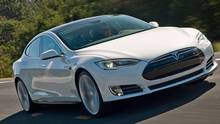The do-or-die model for Tesla
 I drove the very impressive Tesla S electric car last week, which made me think, for the first time, that this company actually has a chance of surviving. The car is refined, comfortable, terrifyingly fast and now available in reasonable quantities. The company has done it.
I drove the very impressive Tesla S electric car last week, which made me think, for the first time, that this company actually has a chance of surviving. The car is refined, comfortable, terrifyingly fast and now available in reasonable quantities. The company has done it.Tesla is supposed to be the vindication of the Silicon Valley innovation model. Coming at the car business from a totally different direction than the 100-year-old, Detroit-based, internal combustion engine loving dinosaurs, Tesla has been touted as the disrupting force that could turn the car industry on its ear.
All that sounds fine but all the company had done until recently was stuff a huge number of cellphone batteries into a tiny Lotus chassis, hook up an electric motor and produce what seemed to me to be the world’s fastest golf cart. The Roadster was horrible to drive but sold for $100,000 a copy to the George Clooneys of the world who wanted to make a statement about driving “emission-free.”
The Tesla S, on the other hand, is a car that was designed and engineered from the ground up to be all-electric – not a conversion from a gasoline-engine car. And how simple they are. There’s a bunch of batteries (about 7,000 Panasonic cellphone batteries) under the floor and a big electric motor in the rear and a fancy computer running the whole thing. Lift the front hood where you’d normally expect an unbelievably complicated gas engine and transmission and all you find is a big empty space (for luggage, groceries, cases of champagne, whatever) and a little spout to refill the windshield washer. An electric car, with economies of scale, and cheaper better batteries should be dirt cheap to build.
The driving manners and red-hot performance of this machine is a thing to behold. It reminds me in many ways of the Porsche Panamera and is comparably priced. But acceleration of an electric car is instant and intense – zero to 100 km/h in about 4-1/2 seconds. Unlike the golf cart-like Roadster, the Tesla S is tight, solid, and rattle free. It is of course totally silent, which may be a good thing (for neighbours) or a bad thing (for drivers) who want that loud expensive exhaust “note” in their ears.
But back to the survivability issue. First, Tesla has now proven that they can manufacture a real car. They bought the NUMMI plant outside San Francisco, that used to be a General Motors/Toyota joint venture, and turned this old monstrosity into a modern, efficient plant.
Second, they’ve created their own intellectual property and don’t licence it from others. In fact, Toyota and Daimler purchase critical components from Tesla.
And maybe most important, they have created a Tesla Brand. Every geek knows who Elon Musk is. He created PayPal, sold it for a fortune and poured it into Tesla. He’s also the guy who created SpaceX, which has the first private-sector space ship, currently supplying the International Space Station.
So what could blow them out of the water? Plenty of things. Although Tesla has some cachet as the true all-electric brand, and a premium brand to boot like Apple, no one knows if electric cars are going anywhere in the mainstream. Tesla can congratulate itself all it wants about “selling out” its first production run, but selling 3,000 cars in a U.S. market of 13 million is peanuts. To make money the company is counting on 20,000 sales next year and want to ramp up to 50,000 after that.
Is there enough demand? Will electric cars become more than a talking point in an affluent driveway? We don’t know. There’s evidence that gasoline prices are trending down for the medium term. I haven’t seen many large cities banning emission-causing vehicles from city centres. That might come and that would push electric cars forward.
So the Tesla S is do-or-die for the company. Musk’s vision is to make electric cars affordable for the masses and necessary for the environment. He’s not home and dry yet, but he’s making great progress.
You can return to the main Market News page, or press the Back button on your browser.

